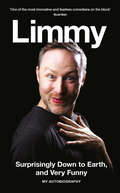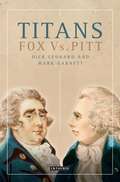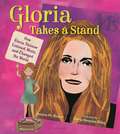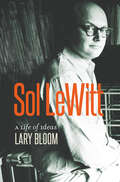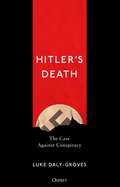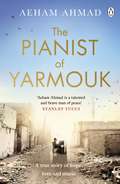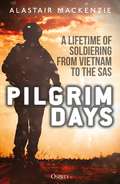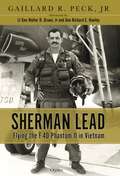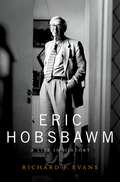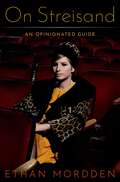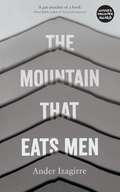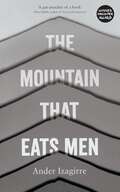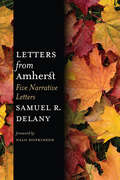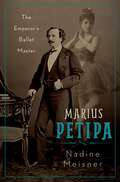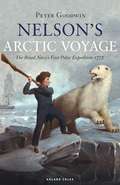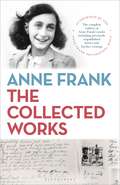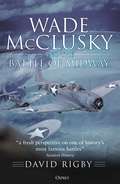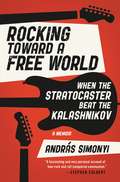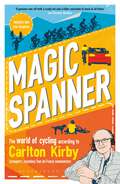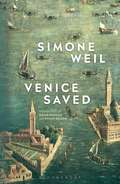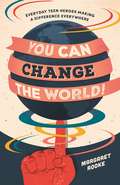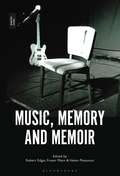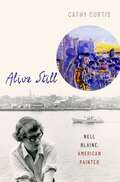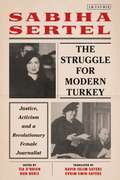- Table View
- List View
Surprisingly Down to Earth, and Very Funny: My Autobiography
by LimmyThe hysterical, shocking and incredibly intimate memoir from one of the most original and unique comedians alive today.
Titans: Fox vs. Pitt
by Dick Leonard Mark GarnettCharles James Fox and William Pitt the Younger were the two political giants of their day - the greatest of orators, and the fiercest of rivals. But did the two men have anything in common? Each was a younger son of distinguished fathers, who themselves had been bitter rivals for power a generation earlier, and each came to prominence at a very young age. Temperamentally, however, they could hardly have been more different. Fox was genial, tolerant, gregarious, self-indulgent, rash, a reckless gambler and a drinking companion of the Prince of Wales (later the Prince Regent and George IV) whereas Pitt was cautious, self-controlled (though also a heavy drinker), calculating, ruthless and misanthropic. Their fates were heavily influenced by their respective relationships with George III, who formed an insensate hostility to Fox, using unconstitutional means to exclude him from power, while favouring Pitt, whom he appointed as Prime Minister at the age of 24, and maintained in office for 17 years (plus a further two years in his second administration). The result was that Fox enjoyed only three very short periods as Foreign Minister, and was effectively Leader of the Opposition for a record 23 years. But he did achieve a late triumph when, following the death of Pitt, he became the dominant member of the `Government of All the Talents' and lived long enough to be able to introduce the bill which abolished the slave trade. Featuring a wide cast of characters, this book sheds new light on the political landscape of Georgian England and two of the leading political players of the age.
Gloria Takes a Stand: How Gloria Steinem Listened, Wrote, and Changed the World
by Jessica M. RinkerPerfect for fans of I Dissent comes an inspirational and empowering account of the life of women's rights icon Gloria Steinem.As a young girl, Gloria Steinem thought for herself and spoke her mind. She read many books by her favorite authors and imagined herself as the heroine of the story.Gloria wished. She read. And imagined.But Gloria grew up during a time when women were not encouraged, or even allowed, to do a lot of the things men could do: go to college, get a job, open a bank account, and more. There were restrictions that made it impossible for women to be independent or equal to men. So, Gloria set out to change that . . .Gloria listened. She watched. And wrote.Gloria believed. She marched. And dreamed.From unconventional childhood, to Smith College, to Ms. magazine, to the women's liberation movement, to feminist icon--Gloria Takes a Stand brings to the page a spirited look at Gloria Steinem's influential life, energizing a new generation of feminists to stand up and demand equal rights for all people.
Sol LeWitt: A Life of Ideas (The Driftless Connecticut Series & Garnet Books)
by Lary BloomSol LeWitt (1928-2007), one of the most influential artists of the twentieth century, upended traditional practices of how art is made and marketed. A key figure in minimalism and conceptualism, he proclaimed that the work of the mind is much more important than that of the hand. For his site-specific work—wall drawings and sculpture in dozens of countries—he created the idea and basic plan and then hired young artists to install the pieces. Though typically enormous and intricate, the physical works held no value. The worth was in the pieces of paper that certified and described them. LeWitt championed and financially supported colleagues, including women artists brushed aside by the bullies of a male-dominated profession. Yet the man himself has remained an enigma, as he refused to participate in the culture of celebrity. Lary Bloom's book draws on personal recollections of LeWitt, whom he knew in the last years of the artist's life, as well as LeWitt's letters and papers and over one hundred original interviews with his friends and colleagues, including Chuck Close, Ingrid Sischy, Philip Glass, Adrian Piper, Jan Dibbets, and Carl Andre. This absorbing chronicle brings new information to our understanding of this important artist, linking the extraordinary arc of his life to his iconic work. Includes 28 illustrations.
Hitler’s Death: The Case Against Conspiracy
by Luke Daly-GrovesDid Hitler shoot himself in the Führerbunker or did he slip past the Soviets and escape to South America? Countless documentaries, newspaper articles and internet pages written by conspiracy theorists have led the ongoing debate surrounding Hitler's last days. Historians have not yet managed to make a serious response. Until now. This book is the first attempt by an academic to return to the evidence of Hitler's suicide in order to scrutinise the most recent arguments of conspiracy theorists using scientific methods. Through analysis of recently declassified MI5 files, previously unpublished sketches of Hitler's bunker, personal accounts of intelligence officers along with stories of shoot-outs, plunder and secret agents, this scrupulously researched book takes on the doubters to tell the full story of how Hitler died.
The Pianist of Yarmouk
by Aeham AhmadThe moving story of one young man's struggle to find peace during war, and the power of music to bring hope to a desperate nation. BBC Radio 4 'Book of the Week'__________A man, a piano, a Syrian street under siege . . .One morning on the outskirts of war-torn Damascus, a starving man stumbles through a once familiar street - now just piles of rubble. Everything he once knew has been destroyed by famine and war. In despair he turns to his only comfort and joy, music, and pushes his piano into the street and begins to play. He plays of love and hope, he plays for his family and for his fellow Syrians. He plays even though he knows he could be killed for doing so.As word of his act of defiance spreads around the world, he becomes a beacon of hope and even resistance. Yet he fears for his wife and children, his elderly parents. And he is right to be scared, because the more he plays, the more he and his family are drawn into danger.Finally he is forced to make a terrible choice - between staying and waiting to die, or saving himself, but this would mean abandoning his family . . .Aeham Ahmad's spellbinding and uplifting true story tells of the triumph of love and hope, of the incredible bonds of family, and the healing power of music in even the very darkest of places.
Pilgrim Days: From Vietnam to the SAS
by Alastair MacKenzie'We are the Pilgrims, master; we shall go, Always a little further; it may be, Beyond that last blue mountain barred with snow.' If there was ever anyone who went a little further, a little beyond, it was Alastair MacKenzie. In a career spanning 30 years, MacKenzie served uniquely with the New Zealand Army in Vietnam, the British Parachute Regiment, the British Special Air Service (SAS), the South African Defence Force's famed ParaBats, the Sultan of Oman's Special Forces and a host of private security agencies and defence contractors. MacKenzie lived the soldier's life to the full as he journeyed 'the Golden Road to Samarkand'. This extraordinary new work from the author of Special Force: The Untold Story of 22nd Special Air Service Regiment (SAS) vividly documents, in a detail that stuns, the experience of infantry combat in Vietnam, life with the Paras, the tempo of selection for UK Special Forces, covert SAS operations in South Armagh and SAS Counter Terrorist training on the UK mainland, vehicle-mounted Pathfinder Brigade insertions into Angola and maritime counter-terrorism work in Oman.
Sherman Lead: Flying the F-4D Phantom II in Vietnam
by Gaillard R. Peck, JrWritten by a pilot who flew near-daily combat missions, this engrossing book is the story of one man, his colleagues and his machine, the mighty F-4 Phantom II, at war.Sherman Lead is the gripping story of a year flying the F-4 in combat during the Vietnam War, told through the eyes of a fighter pilot. Operating out of Ubon Royal Thai Air Base, Thailand in 1968–69, Gail Peck and his squadronmates in the 433rd Tactical Fighter Squadron of the 8th Tactical Fighter Wing were tasked with flying combat missions into North Vietnam and Laos at this time as part of Operations Rolling Thunder and Steel Tiger. The F-4 was heavily involved in the air-to-ground mission at this time, with targets being well defended by enemy anti-aircraft artillery and surface-to-air missiles. Gail Peck's arrival in-theatre coincided with the beginning of electro-optical and laser guided 'smart' bomb combat operations. There were periods of fierce combat interspersed with lulls, and the fighting was intense and unforgettable to those who participated. Some men lived through it, and others died without a clear understanding of why.
Eric Hobsbawm: A Life in History
by Richard J. EvansEric Hobsbawm's works have had a nearly incalculable effect across generations of readers and students, influencing more than the practice of history but also the perception of it. Born in Alexandria, Egypt, of second-generation British parents, Hobsbawm was orphaned at age fourteen in 1931. Living with an uncle in Berlin, he experienced the full force of world economic depression, and in the charged reaction to it in Germany was forced to choose between Nazism and Communism, which was no choice at all. Hobsbawm's lifelong allegiance to Communism inspired his pioneering work in social history, particularly the trilogy for which he is most famous--The Age of Revolution, The Age of Capital, and The Age of Empire--covering what he termed "the long nineteenth century" in Europe. Selling in the millions of copies, these held sway among generations of readers, some of whom went on to have prominent careers in politics and business. In this comprehensive biography of Hobsbawm, acclaimed historian Richard Evans (author of The Third Reich Trilogy, among other works) offers both a living portrait and vital insight into one of the most influential intellectual figures of the twentieth century. Using exclusive and unrestricted access to the unpublished material, Evans places Hobsbawm's writings within their historical and political context. Hobsbawm's Marxism made him a controversial figure but also, uniquely and universally, someone who commanded respect even among those who did not share-or who even outright rejected-his political beliefs. Eric Hobsbawm: A Life in History gives us one of the 20th century's most colorful and intellectually compelling figures. It is an intellectual life of the century itself.
On Streisand: An Opinionated Guide
by Ethan MorddenShe said, "I became a singer because I couldn't get work as an actress," but Barbra Streisand not only became both but revolutionized the two professions. Her music transformed the smooth, uninflected style of the Frank Sinatras and Ella Fitzgeralds into an engine of dramatic vocalism in which each song is like a miniature three-act play. And Streisand's films changed forever the ideal of how a movie star chooses roles, going from musicals to dramas to comedies, from period fare to ultra-modern tales, from Funny Girl to The Way We Were to Yentl. On Streisand begins with a broad year-by-year outline of the landmark achievements and a few of her more whimsical escapades, as when Rex Reed apologizes for an oafish interview piece and she responds with "I had more respect for him when he hated me." This is followed by a long essay on how Streisand's idiosyncratic self-realization marks her as a unique national treasure, an artist without limits. Then comes the major part of the book, a work-by-work analysis. This section is broken down into separate chapters, each organized chronologically: the stage shows, then the television shows and concerts, then the movies, and last (because longest) the recordings. Throughout, Mordden follows Streisand's independence, which he sees as her central quality. Throughout all of the chapters on Streisand's shows, concerts, films, and recordings, Mordden illustrates how she was exercising individualistic control of her career from her very first audition, and how the rest of her professional life unfolded from that point. A book written by an opinionated expert whose prose is consistently full of flair and wit, On Streisand: An Opinionated Guide will appeal to general readers in all aspects of American life that Streisand has touched, from film to television to popular music to stardom.
The Mountain that Eats Men
by Ander IzagirreFrom the 16th century, the mines of Potosí, perched high in the Andes, bankrolled the Spanish empire. During those years immense wealth allowed the city to grow larger than London at the time and the mountain was quickly given the epithet Cerro Rico – the 'rich mountain'. But today, Potosí's inhabitants are some of the poorest in South America while the mountain itself has been so greedily plundered that its summit is on the verge of collapsing. So many people have died in the mines that the Cerro Rico is now called the 'mountain that eats men'.In this captivating, moving tale of harrowing bravery and wistful beauty Ander Izagirre tells the story of the mountain and those who risk their lives in its shadow through the eyes of Alicia – a 14-year-old girl working in the dark, dangerous mines to support her family. Through her eyes we can come to know the story of postcolonial Bolivia.
The Mountain that Eats Men
by Ander IzagirreFrom the 16th century, the mines of Potosí, perched high in the Andes, bankrolled the Spanish empire. During those years immense wealth allowed the city to grow larger than London at the time and the mountain was quickly given the epithet Cerro Rico – the 'rich mountain'. But today, Potosí's inhabitants are some of the poorest in South America while the mountain itself has been so greedily plundered that its summit is on the verge of collapsing. So many people have died in the mines that the Cerro Rico is now called the 'mountain that eats men'.In this captivating, moving tale of harrowing bravery and wistful beauty Ander Izagirre tells the story of the mountain and those who risk their lives in its shadow through the eyes of Alicia – a 14-year-old girl working in the dark, dangerous mines to support her family. Through her eyes we can come to know the story of postcolonial Bolivia.
Letters from Amherst: Five Narrative Letters
by Samuel R. DelanyFive substantial letters written from 1989 to 1991 bring readers into conversation with Hugo and Nebula Award winning-author Samuel Delany. With engaging prose, Delany shares details about his work, his relationships, and the thoughts he had while living in Amherst and teaching as a professor at the UMASS campus just outside of town, in contrast to the more chaotic life of New York City. Along with commentary on his own work and the work of other writers, he ponders the state of America, discusses friends who are facing AIDS and other ailments, and comments on the politics of working in academia. Two of the letters, which tell the story of his meeting his life partner Dennis, became the basis of his 1995 graphic novel, Bread & Wine. Another letter describes the funeral of his uncle Hubert T. Delany, former judge and well-known civil rights activist, and leads to reflections on his family's life in 1950s Harlem. Another details a visit from science fiction writer and critic Judith Merril, and in another he gives a portrait of his one-time student Octavia E. Butler, who by then has become his colleague. In addition, an appendix shares ten letters Delany sent to his daughter while she attended summer camp between 1984 and 1988. These letters describe Delany's daily life, including visitors to his upper-west-side apartment, his travels for work and pleasure, lectures attended, movies viewed, and exhibits seen.
Marius Petipa: The Emperor's Ballet Master
by Nadine MeisnerOne of the most important ballet choreographers of all time, Marius Petipa (1818 - 1910) created works that are now mainstays of the ballet repertoire. Every day, in cities around the world, performances of Swan Lake and The Sleeping Beauty draw large audiences to theatres and inspire new generations of dancers, as does The Nutcracker during the winter holidays. These are his best-known works, but others - Don Quixote, La Bayadère - have also become popular, even canonical components of the classical repertoire, and together they have shaped the defining style of twentieth-century ballet. The first biography in English of this monumental figure of ballet history, Marius Petipa: The Emperor's Ballet Master covers the choreographer's life and work in full within the context of remarkable historical and political surroundings. Over the course of ten well-researched chapters, Nadine Meisner explores Marius Petipa's life and legacy: the artist's arrival in Russia from his native France, the socio-political tensions and revolution he experienced, his popularity on the Russian imperial stage, his collaborations with other choreographers and composers (most famously Tchaikovsky), and the conditions under which he worked, in close proximity to the imperial court. Meisner presents a thrilling and exhaustive narrative not only of Petipa's life but of the cultural development of ballet across the 19th and early 20th centuries. The book also extends beyond Petipa's narrative with insightful analyses of the evolution of ballet technique, theatre genres, and the rise of male dancers. Richly illustrated with archival photographs, this book unearths original material from Petipa's 63 years in Russia, much of it never published in English before. As Meisner demonstrates, the choreographer laid the foundations for Soviet ballet and for Diaghilev's Ballets Russes, the expatriate company which exercised such an enormous influence on ballet in the West, including the Royal Ballet and Balanchine's New York City Ballet. After Petipa, Western ballet would never be the same.
The Real Interior
by Nthabi Taukobong“In my own home is where my journey of healing began.” – NTHABI TAUKOBONGThe Real Interior not only allows the reader a behind-the-scenes peek into the glitz and glamour of design and décor, but into a career once never considered an option for a young girl, born in Soweto.As one of the first black and very recognisable faces of Interior Design in Africa, Nthabi Taukobong was thrust into the limelight from the very start of her profession. Spanning a career of more than 23 years she has worked on esteemed residential and leisure projects for presidents, African royalty, captains of industry and five-star hotels, to name but a few.Through the rough and often very challenging terrain of her chosen career, sprinkled generously with the high-end glamour of prestigious interiors that Nthabi has been privileged to work on, she learned that she, in fact, had to be seated right within her own interior before she could offer anything further to those in search of her creative gift.And as she searched and explored the greater world of design, trying to grasp what it really took to be an esteemed designer, the journey unexpectedly brought her right back into her own home. Not only Nthabi’s physical home, but also to her inner-home, the place that she refers to as her real interior.It was in writing a letter one evening, congratulating herself on reaching the milestone of 21 years in her career, that Nthabi discovered she was not only writing to herself, but to every creative.Her letter ended up being an entire book and Nthabi finally understood how her unique story could inspire and encourage others.
Nelson's Arctic Voyage: The Royal Navy’s first polar expedition 1773
by Peter GoodwinIn the summer of 1773 the 14-year old Horatio Nelson took part in an expedition to the Arctic, which came close to ending his naval career before it had begun. The expedition was to find a navigable northern passage between the Atlantic and Pacific, and was supported by the Royal Society and King George III. Two bomb vessels HMS Racehorse and Carcass were fitted out and strengthened under the command of Captain Hon. Constantine Phipps. It was an extremely cold Arctic summer and the ships became locked in ice far from Spitzbergen and were unable to cut their way out until days later when the wind changed and the ice broke up. The ships were extricated and returned home.On the trip, the young Nelson had command of one of the smaller boats of the ships, a four-oared cutter manned by twelve seamen. In this he helped to save the crew of a boat belonging to the Racehorse from an attack by a herd of enraged walruses. He also had a more famous encounter with a polar bear, while attempting to obtain a bearskin as a present for his father, an exploit that later became part of the Nelson legend.Drawing on the ship's journals and expedition commander Phipps' journal from the National Archives, the book creates a picture of the expedition and life on board. Using the ships' muster books it also details the ship's crews giving the different roles and ranks in the ships. The book is illustrated using some of the ship's drawings and charts and pictures of many objects used on the ship, while a navigational chart of the route taken has been created from the logbooks. The book also looks at the overall concept of naval exploration as set in train by Joseph Banks and the Royal Society. The fact that the expedition failed as a result of poor planning with potentially tragic results demonstrates the difficulties and uncertainties of such an expedition. It also looks at a great naval commander at the earliest stage of his career and considers how the experience might have shaped his later career and attitudes. Other great captains and voyages are discussed alongside Nelson, including Captain Cook and his exploration of the south seas and the later ill-fated northern journeys of Franklin and Shackleton.
Anne Frank: The Collected Works
by Anne Frank FondsAnne Frank's diary is one of the most recognised and widely read books of the Second World War. Hundreds of thousands of people visit the Anne Frank House on the Prinsengracht in Amsterdam each year to see the annexe where Anne and her family hid from the occupying forces, before eventually being deported to Auschwitz in 1944. Only Anne's father, Otto, survived the Holocaust.Anne Frank: The Collected Works includes each of the versions of Anne's world-famous diary including the 'A' and 'B' diaries now in continuous, readable form, and the definitive text ('D') edited by renowned translator and author Mirjam Pressler. For the first time readers have access to Anne's letters, personal reminiscences, daydreams, essays and notebook of favourite quotes. Also included are background essays by notable writers such as historian Gerhard Hirschfeld (University of Stuttgart) and Francine Prose (Bard College) on topics such as 'Anne Frank's Life', 'The History of the Frank Family' and 'The Publication History of Anne Frank's diary', as well as numerous photographs of the Franks and the other occupants of the annexe.An essential book for scholars and general readers alike, The Collected Works brings together for the first time Anne Frank's complete writings, together with important images and documents. Supported by the Anne Frank Fonds in Basel, Switzerland, set up by Otto Frank to act as the guardian of Anne's work, this is a landmark publication marking the anniversary of 90 years since Anne's birth in 1929.
Wade McClusky and the Battle of Midway
by David RigbyDuring the Battle of Midway in June 1942, US Navy dive bomber pilot Wade McClusky proved himself to be one of the greatest pilots and combat leaders in American history, but his story has never been told – until now. It was Wade McClusky who remained calm when the Japanese fleet was not where it was expected to be. It was he who made the counterintuitive choice to then search to the north instead of to the south. It was also McClusky who took the calculated risk of continuing to search even though his bombers were low on fuel and may not have enough to make it back to the Enterprise. His ability to remain calm under enormous pressure played a huge role in the US Navy winning this decisive victory that turned the tide of war in the Pacific. This book is the story of exactly the right man being in exactly the right place at exactly the right time. Wade McClusky was that man and this is his story.
Rocking Toward a Free World: When the Stratocaster Beat the Kalashnikov
by András SimonyiFrom renowned diplomat and musician András Simonyi -- whom Stephen Colbert calls "the only ambassador I know who can shred a mean guitar!" -- comes a timely and revealing memoir about growing up behind the Iron Curtain and longing for freedom while chasing the great power of rock and roll. p.p1 {margin: 0.0px 0.0px 0.0px 0.0px; text-indent: 36.0px; font: 12.0px Arial} In ROCKING TOWARD A FREE WORLD, Simonyi charts the struggle of growing up in 1960s Hungary, a world in which listening to his favorite music was a powerful but furtive endeavor: records were black-market bootlegs; concerts were held under strict control, even banned; protests were folded into song lyrics. Get caught listening to Western radio could mean punishment, maybe prison. That didn't matter to Simonyi, who from an early age felt the tremendous pull of rock and roll, the lure of American popular culture, and a burning desire to buck the system. Inspired by the protest music coming out of the West, he formed a band and became part of Hungary's burgeoning rock scene. Then came the setbacks: tightening of control by the state, the seemingly inescapable weight of an authoritarian system, and the collapse of Simonyi's own dreams of stardom. A story of youth, rebellion, and hope, ROCKING TOWARD A FREE WORLD sheds new light on two of the most powerful forces of the modern age: global democracy and rock and roll. Deeply vital and compelling, Simonyi's memoir chronicles how one man's tremendous connection to American and British popular music inspired him to make a difference in his country and, eventually, the world. It tells the story of a generation, as played out in song lyrics and guitar riffs. p.p1 {margin: 0.0px 0.0px 0.0px 0.0px; font: 13.0px Times} p.p2 {margin: 0.0px 0.0px 0.0px 0.0px; font: 13.0px Times; min-height: 16.0px}
Magic Spanner: The World of Cycling According to Carlton Kirby
by Carlton Kirby Robbie BroughtonPrepare to be entertained as legendary Eurosport cycling commentator Carlton Kirby shares his tales from the road, taking you behind the scenes of the world's greatest cycle races.'A genuine one-off with a ready wit and a killer anecdote to hand at all times' Ian Cleverly, Rouleur'Carlton Kirby is no ordinary cycling commentator, so it is not surprising that this very entertaining book is no ordinary Grand Tour on a bicycle. A very enjoyable journey for everyone' Phil Liggett MBE, NBC Tour de France commentator'Carlton Kirby's infectious enthusiasm, wine tips and Shakespearean joy for inventing words makes every stage of a bike race a must-watch event' Matt Butler, i newspaper With a candid authority that comes from over 25 years commentating on the world's biggest cycling races, legendary Eurosport commentator Carlton Kirby isn't afraid to tell it like it really is. Witty, outrageous and often outspoken, Magic Spanner is an insider's view of life on cycling's Grand Tours, including the Tour de France, Giro D'Italia, Vuelta a España and the classics, all delivered in the inimitable style for which Carlton has become globally famous.Peppered with hilarious anecdotes of life on the road with Tour legend Sean Kelly, Carlton gives us an expert, behind-the-scenes view – one that the average fan rarely gets to see or hear about. As well as sharing his various bugbears (including crazy spectators in mankinis to the more serious issues of rider safety), Carlton also lifts the lid on team strategies, and delves into some of cycling's more questionable ethics.Delivering a mix of expert opinion and trademark wit, Carlton covers the funny, the serious and the more bizarre moments on the professional cycling caravan.
Venice Saved
by Simone WeilTowards the end of her life, the French philosopher and mystic Simone Weil (1909-43) was working on a tragedy, Venice Saved. Appearing here in English for the first time, this play explores the realisation of Weil's own thoughts on tragedy. A figure of affliction, a central theme in Weil's religious metaphysics, the central character offers a unique insight into Weil's broader philosophical interest in truth and justice, and provides a fresh perspective on the wider conception of tragedy itself.The play depicts the plot by a group of Spanish mercenaries to sack Venice in 1618 and how it fails when one conspirator, Jaffier, betrays them to the Venetian authorities, because he feels compassion for the city's beauty. The edition includes notes on the play by the translators as well as introductory material on: the life of Weil; the genesis and purport of the play; Weil and the tragic; the issues raised by translating Venice Saved. With additional suggestions for further reading, the volume opens up an area of interest and research: the literary Weil.
You Can Change the World!: Everyday Teen Heroes Making a Difference Everywhere
by Margaret RookeThis inspirational book tells the stories of more than 50 of today's teenagers who've dared to change the world they live in. It's been written to show other teens they can do the same.Bestselling author Margaret Rooke asks teens about their experiences of being volunteers, social entrepreneurs and campaigners, online and beyond. They explain how they have survived in a world often obsessed by celebrity, social media and appearance, by refusing to conform to other's expectations. If you want to achieve against the odds and create genuine impact, this book may be the encouragement you need.The interviews cover race, sexuality, violence, grief, neurodiversity, bullying and other issues central to life today.Read about teens from around the world includingTrisha, 18, who has invented a way of preventing bullying onlineDillon, 18, who takes damaged and donated clothing and upcycles it for the homeless Guro, 13, who persuaded a pop band to portray women differently in its video'Happy D', 19, who learned to read at 14 and found ways to build his confidenceHeraa, 19, who fights Islamophobia online.Ruben, 18, bullied because of Down's Syndrome, now a successful actorLucy who, at 14, walked into Tesco head office and persuaded them not to sell eggs from caged hens.Cameron, 17, who has cerebral palsy and was side-lined by soccer teams who set up his own team 'Adversity United'Alex, 18, who broke his back on his 15th birthday and says his injury has taught him to care for othersAmika, 18, who fights 'Period Poverty'Jesse, 15, who's seven feet tall and embraces his statureBilly, 18, who wore full make up every day at high schoolAnd many more
Music, Memory and Memoir
by Robert Edgar Fraser Mann Helen PleasanceMusic, Memory and Memoir provides a unique look at the contemporary cultural phenomenon of the music memoir and, leading from this, the way that music is used to construct memory. Via analyses of memoirs that consider punk and pop, indie and dance, this text examines the nature of memory for musicians and the function of music in creating personal and cultural narratives. This book includes innovative and multidisciplinary approaches from a range of contributors consisting of academics, critics and musicians, evaluating this phenomenon from multiple academic and creative practices, and examines the contemporary music memoir in its cultural and literary contexts.
Alive Still: Nell Blaine, American Painter
by Cathy CurtisAmong the women artists who came to prominence in the postwar era in New York, painter Nell Blaine had a uniquely hard-won career. In her mid-thirties, her horizons seemed limitless. Her shows received glowing reviews, ARTnews honored her with a lengthy feature article, and one of her paintings hung in the Whitney Museum. Then, on a trip to Greece, Blaine developed polio, rendering her a paraplegic. Angry at being told she would never paint again, she taught herself to hold a brush with her left hand and regained her skill. In Alive Still, author Cathy Curtis tells the story of Blaine's life and career for the first time by investigating the ways her experience of illness colored her personality and the evolving nature of her work, the importance of her Southern roots, and the influence of her bisexuality (and, in the latter part of her life, long term lesbian relationships) on her understanding of the world. Alive Still draws upon Blaine's unpublished diaries; her published writing; career-spanning interviews and reviews; and correspondence to and from family members, lovers, and the artists, poets, publishers, rescuers in Greece, and neighbors she knew. In addition, Curtis has conducted interviews with surviving artists and other individuals in Blaine's circle, including two of her longtime lovers. Featuring illustrations of Blaine's work and snapshots of family and friends, Alive Still is a compelling narrative of a leading, productive, and passionate woman artist who overcame the setbacks of disability.
The Struggle for Modern Turkey: Justice, Activism and a Revolutionary Female Journalist
by Sabiha SertelSabiha Sertel was born into revolution in 1895, as an independent Turkey rose out of the dying Ottoman Empire. The nation's first professional female journalist, her unrelenting push for democracy and social reforms ultimately cost Sertel her country and freedom.Shortly before her death in 1968, Sertel completed her autobiography Roman Gibi (Like a Novel), which was written during her forced exile in the Soviet Union. Translated here into English for the first time, and complete with a new introduction and comprehensive annotations, it offers a rare perspective on Turkey's history as it moved to embrace democracy, then violently recoiled. The book reveals the voice of a passionate feminist and committed socialist who clashes with the young republic's leadership. A unique first-hand account, the text foreshadows Turkey's increasingly authoritarian state. Sertel offers her perspective on the fierce divisions over the republic's constitution and covers issues including freedom of the press, women's civil rights and the pre-WWII discussions with European leaders about Hitler's rising power.
